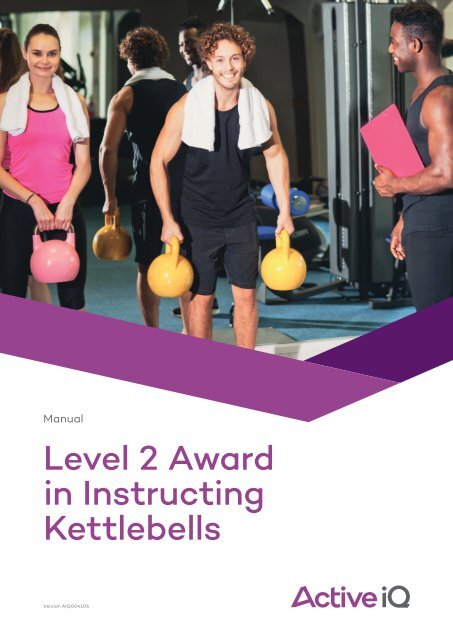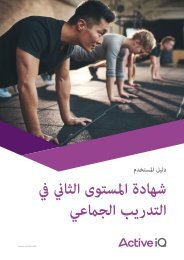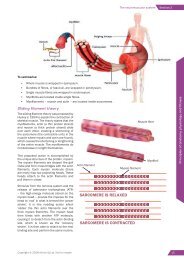Active IQ Level 2 Award in Instructing Kettlebells (sample manual)
For more information, please visit http://www.activeiq.co.uk/qualifications/level-2/active-iq-level-2-award-in-instructing-kettlebells
For more information, please visit http://www.activeiq.co.uk/qualifications/level-2/active-iq-level-2-award-in-instructing-kettlebells
Create successful ePaper yourself
Turn your PDF publications into a flip-book with our unique Google optimized e-Paper software.
Manual<br />
<strong>Level</strong> 2 <strong>Award</strong><br />
<strong>in</strong> Instruct<strong>in</strong>g<br />
<strong>Kettlebells</strong><br />
Version A<strong>IQ</strong>004106
Section 1<br />
Plann<strong>in</strong>g a kettlebell<br />
session<br />
Introduction<br />
A kettlebell is a traditional Russian cast iron weight that looks like a cannon<br />
ball with a handle; essentially a Russian dumbbell, known as a Girya.<br />
Objectives<br />
By the end of this section you will be able to:<br />
• identify the historical background of kettlebell tra<strong>in</strong><strong>in</strong>g<br />
• identify the benefits of us<strong>in</strong>g kettlebells<br />
• identify how to <strong>in</strong>corporate kettlebell lifts <strong>in</strong>to an exercise programme<br />
• identify the safety considerations for <strong>in</strong>struct<strong>in</strong>g a kettlebell session<br />
• design a kettlebell programme.
Section 1: plann<strong>in</strong>g a kettlebell session<br />
Background<br />
In Russia and Eastern Europe kettlebell lift<strong>in</strong>g is an<br />
<strong>in</strong>ternational sport with local, national and world<br />
championships.<br />
Tak<strong>in</strong>g a closer look at a kettlebell we can see three<br />
ma<strong>in</strong> parts: the handle, the horns and the bell.<br />
<strong>Kettlebells</strong> are well established tra<strong>in</strong><strong>in</strong>g tools. They’re<br />
used by athletes, mixed martial artists, power lifters,<br />
military forces and everyday gym goers. They provide<br />
a tra<strong>in</strong><strong>in</strong>g system that is highly adaptable, cheap and<br />
easy to learn, and develops certa<strong>in</strong> techniques that<br />
may be useful <strong>in</strong> other tra<strong>in</strong><strong>in</strong>g modalities.<br />
Kettlebell exercises or ‘lifts’ are very effective for<br />
various physical fitness goals <strong>in</strong>clud<strong>in</strong>g develop<strong>in</strong>g<br />
strength, power, muscle endurance, flexibility, motor<br />
skills and a good body composition.<br />
History<br />
Handle<br />
Horns<br />
Bell<br />
It’s difficult to p<strong>in</strong>po<strong>in</strong>t the exact orig<strong>in</strong>s of kettlebells.<br />
It’s likely that kettlebells were used <strong>in</strong> Russia hundreds<br />
of years ago <strong>in</strong> village strength competitions between<br />
‘Bogatirs’ – a traditional Russian term mean<strong>in</strong>g hero<br />
or valiant warrior.<br />
Another suggestion is that kettlebells were created as<br />
a counterweight for weigh<strong>in</strong>g and measur<strong>in</strong>g goods<br />
when trad<strong>in</strong>g and barter<strong>in</strong>g and sometimes these<br />
weights would be used by men to display feats of<br />
strength.<br />
Typical fitness gyms packed with futuristic look<strong>in</strong>g<br />
cardiovascular and resistance mach<strong>in</strong>es are a<br />
relatively modern day phenomenon. These gyms<br />
provide a marked contrast to some of the early<br />
gymnasiums and the equipment used <strong>in</strong> them.<br />
Sigmund Kle<strong>in</strong> set up a weightlift<strong>in</strong>g gym <strong>in</strong> New<br />
York that became famous <strong>in</strong> the 1930s and 1940s<br />
for produc<strong>in</strong>g strongmen and kettlebells were a<br />
popular item of tra<strong>in</strong><strong>in</strong>g equipment.<br />
Kettlebell tra<strong>in</strong><strong>in</strong>g has its roots <strong>in</strong> the Russian<br />
Federation and has more recently been <strong>in</strong>troduced<br />
<strong>in</strong> the West.<br />
Soviet weightlift<strong>in</strong>g legends such as Vlasov,<br />
Zhabot<strong>in</strong>skiy, and Alexeyev started their Olympic<br />
careers with old-fashioned kettlebells.<br />
The Russian Special Forces have identified the potential<br />
of kettlebells. The official Soviet armed forces strength<br />
tra<strong>in</strong><strong>in</strong>g <strong>manual</strong> pronounced kettlebell drills to be ‘one<br />
of the most effective means of strength development’<br />
represent<strong>in</strong>g ‘a new era <strong>in</strong> the development of human<br />
strength-potential’.<br />
One of the modern day proponents of kettlebells<br />
is Pavel Tsatsoul<strong>in</strong>e (a nationallyranked kettlebell<br />
competitor). Orig<strong>in</strong>ally born <strong>in</strong> the former USSR,<br />
Tsatsoul<strong>in</strong>e is partly responsible for the resurgence of<br />
kettlebell tra<strong>in</strong><strong>in</strong>g <strong>in</strong> the West.<br />
Kettlebell timel<strong>in</strong>e<br />
500 BC Ancient Greek dumbbells called<br />
‘halteres’ are used <strong>in</strong> ancient sports.<br />
50 BC <strong>Kettlebells</strong> or similar pieces of<br />
equipment may have been used<br />
by gladiators <strong>in</strong> ancient Rome.<br />
1000s<br />
<strong>Kettlebells</strong> are used <strong>in</strong> strength<br />
competitions and for weigh<strong>in</strong>g and<br />
measur<strong>in</strong>g goods.<br />
1704 Kettlebell appears <strong>in</strong> the Russian<br />
dictionary.<br />
1900s<br />
Russian circus events and<br />
performers such as Louis Cyr use<br />
weighted devices.<br />
1913 Russian magaz<strong>in</strong>e Hercules<br />
reports: ‘Not a s<strong>in</strong>gle sport develops<br />
our muscular strength and bodies<br />
as well as kettlebell athletics.’<br />
1930s<br />
Sigmund Kle<strong>in</strong> sets up a famous<br />
weightlift<strong>in</strong>g gym <strong>in</strong> New York –<br />
kettlebells become a popular item<br />
of tra<strong>in</strong><strong>in</strong>g equipment.
this k<strong>in</strong>d of work, such as:<br />
• hypertension<br />
• osteoarthritis/rheumatoid arthritis<br />
• pregnancy<br />
• severe osteoporosis<br />
• obesity<br />
Programme design<br />
To design an effective programme we need a series of<br />
logically progressive tra<strong>in</strong><strong>in</strong>g phases. It’s important to<br />
consider the client’s lifestyle, time available, tra<strong>in</strong><strong>in</strong>g<br />
status, environment, equipment available, their likes<br />
and dislikes, and their objectives.<br />
Power<br />
Strength<br />
Hypertrophy<br />
Muscle endurance<br />
The ‘resistance tra<strong>in</strong><strong>in</strong>g progression pyramid’ shows<br />
the various types of tra<strong>in</strong><strong>in</strong>g goal that can be targeted<br />
by kettlebells.<br />
Warm-up and cool-down<br />
An appropriate warm-up for the client, environment<br />
and tra<strong>in</strong><strong>in</strong>g session must be completed to prepare<br />
them for the lifts that follow. It should consist of a<br />
pulse raiser, dynamic stretches and warm-up drills.<br />
Also a cool-down must be <strong>in</strong>cluded to return the<br />
body to a rest<strong>in</strong>g state. This should consist of a pulse<br />
lower<strong>in</strong>g activity and stretches to ma<strong>in</strong>ta<strong>in</strong> or develop<br />
flexibility.<br />
Ma<strong>in</strong> condition<strong>in</strong>g session<br />
Basic programme design rules consist of the<br />
follow<strong>in</strong>g:<br />
• complex movements early (compound<br />
exercises)<br />
• large muscle groups first<br />
• balanced muscle group selection<br />
• synergist/fixators last (isolation).<br />
Us<strong>in</strong>g the sw<strong>in</strong>g may be the first step for kettlebell<br />
beg<strong>in</strong>ners. Exist<strong>in</strong>g exercises can be <strong>in</strong>corporated<br />
<strong>in</strong>to a kettlebell rout<strong>in</strong>e.<br />
Workouts can be specifically designed to stress each<br />
of the energy systems (creat<strong>in</strong>e phosphate, lactate<br />
and aerobic) by manipulat<strong>in</strong>g programme variables.<br />
Set and reps guidel<strong>in</strong>es<br />
Some kettlebell lifts are more dynamic or explosive<br />
than others and may be suited to certa<strong>in</strong> tra<strong>in</strong><strong>in</strong>g<br />
goals, such as power. So, it’s important to th<strong>in</strong>k<br />
about exercise selection <strong>in</strong> tra<strong>in</strong><strong>in</strong>g for specific goals.<br />
The time that muscles are under tension dur<strong>in</strong>g<br />
particular lifts can also be used to determ<strong>in</strong>e the<br />
length of sets <strong>in</strong> order to conform to various tra<strong>in</strong><strong>in</strong>g<br />
goals.<br />
Tra<strong>in</strong><strong>in</strong>g goal Strength Hypertrophy Endurance<br />
Intensity High Moderate Low<br />
Load as % of 1 RM >85% 67-85%
Section 2: Instruct<strong>in</strong>g a kettlebell session<br />
Preparation<br />
Warm-up exercise drills can be used <strong>in</strong> preparation for<br />
the ma<strong>in</strong> lifts. Such warm-up drills are an excellent<br />
means of <strong>in</strong>troduc<strong>in</strong>g kettlebells to beg<strong>in</strong>ners and will<br />
also improve technique for the more complex lifts.<br />
Practice and correction is the key to achiev<strong>in</strong>g sound<br />
kettlebell technique. There are also various drills that<br />
can help solve technique issues for each lift.<br />
Good postural awareness is important for safe and<br />
effective kettlebell lift<strong>in</strong>g; keep<strong>in</strong>g a neutral sp<strong>in</strong>e is<br />
paramount, as this will place m<strong>in</strong>imal stress on the<br />
passive structures of the sp<strong>in</strong>e (ligaments and discs).<br />
“Apply<strong>in</strong>g postural work to your kettlebell tra<strong>in</strong><strong>in</strong>g will<br />
help you learn faster and will assist your development<br />
of strength, speed, and stam<strong>in</strong>a….When optimal<br />
(or at least, better) posture is achieved, the tonic<br />
muscles do their job to stabilise the body, allow<strong>in</strong>g<br />
the phasic muscles to focus on what they do best —<br />
lift<strong>in</strong>g and mov<strong>in</strong>g the bell.”<br />
(Caldwell, 2008)<br />
The core should be activated on all kettlebell lifts to<br />
develop and aid stability. There are various breath<strong>in</strong>g<br />
and core activation techniques used by lifters to<br />
<strong>in</strong>crease potential force production.<br />
Positive teach<strong>in</strong>g skills must be applied to all kettlebell<br />
sessions. Encourage the use of kettlebells without<br />
negativity or discrim<strong>in</strong>ation, adapt the teach<strong>in</strong>g<br />
style to each client’s preferences and make sessions<br />
<strong>in</strong>dividual and fun.<br />
Warm-up drills<br />
Some kettlebell exercises are whole body, <strong>in</strong>tegrated<br />
movements that are technically demand<strong>in</strong>g. The<br />
follow<strong>in</strong>g drills can be used for teach<strong>in</strong>g correct<br />
technique as well as warm<strong>in</strong>g up. The drills will<br />
<strong>in</strong>troduce some specific kettlebell techniques and aim<br />
to activate muscles needed dur<strong>in</strong>g the performance<br />
of various exercises.<br />
Bridge<br />
Overview Primary muscles Teach<strong>in</strong>g po<strong>in</strong>ts<br />
The bridge is an<br />
excellent drill<br />
to help clients<br />
activate the<br />
hamstr<strong>in</strong>gs and<br />
gluteal muscles<br />
<strong>in</strong> preparation for<br />
exercises such as<br />
the sw<strong>in</strong>g.<br />
• hamstr<strong>in</strong>gs<br />
• gluteal muscles<br />
• erector sp<strong>in</strong>ae<br />
• core<br />
1. Beg<strong>in</strong> by ly<strong>in</strong>g flat on the floor <strong>in</strong> the sup<strong>in</strong>e position with<br />
knees bent, feet flat, toes po<strong>in</strong>t<strong>in</strong>g straight ahead and<br />
arms by sides.<br />
2. Activate the core by draw<strong>in</strong>g the navel towards the sp<strong>in</strong>e<br />
and squeez<strong>in</strong>g the glutes.<br />
3. With the core activated and glutes squeezed, lift the hips<br />
off the ground to form a straight l<strong>in</strong>e between knees and<br />
shoulders.<br />
4. Hold and slowly return the hips to the floor, touch<strong>in</strong>g the<br />
floor momentarily before repeat<strong>in</strong>g.
Plank<br />
Overview Primary muscles Teach<strong>in</strong>g po<strong>in</strong>ts<br />
The plank is a<br />
drill that can<br />
be used to help<br />
activate the core<br />
and encourage<br />
abdom<strong>in</strong>al brac<strong>in</strong>g.<br />
A feel<strong>in</strong>g of<br />
connect<strong>in</strong>g the<br />
core can also<br />
be achieved by<br />
activat<strong>in</strong>g the<br />
glutes.<br />
• core<br />
1. Adopt a completely neutral position – feet apart at hip<br />
width, neutral sp<strong>in</strong>e, head <strong>in</strong> l<strong>in</strong>e with the sp<strong>in</strong>e and<br />
elbows directly below the shoulders.<br />
2. Hold the body (<strong>in</strong> an isometric contraction) off the floor<br />
with the core activated.<br />
Press ups<br />
Overview Primary muscles Teach<strong>in</strong>g po<strong>in</strong>ts<br />
Press ups<br />
are useful for<br />
<strong>in</strong>tegrat<strong>in</strong>g the core<br />
activation achieved<br />
by exercises, such<br />
as the plank, <strong>in</strong>to<br />
movements<br />
<strong>in</strong>volv<strong>in</strong>g the<br />
limbs.<br />
• pectorals<br />
• deltoid<br />
• triceps<br />
• core<br />
1. Take the plank position, but take the bodyweight on the<br />
hands by plac<strong>in</strong>g them slightly wider than shoulder width<br />
apart.<br />
2. With the core activated, lower the body by flex<strong>in</strong>g the<br />
elbows while ma<strong>in</strong>ta<strong>in</strong><strong>in</strong>g a level position.<br />
3. Lower until the elbows reach 90 degrees.<br />
4. Press the body upwards to return to the start position.<br />
Squats<br />
Overview Primary muscles Teach<strong>in</strong>g po<strong>in</strong>ts<br />
Squats are an ideal<br />
warm-up for many<br />
kettlebell exercises<br />
<strong>in</strong>clud<strong>in</strong>g the<br />
sw<strong>in</strong>g, as it will<br />
work the majority<br />
of the muscles<br />
needed.<br />
• quadriceps<br />
• calves<br />
• hamstr<strong>in</strong>gs<br />
• core<br />
• gluteal muscles<br />
1. Feet shoulder width apart.<br />
2. Brace the abdom<strong>in</strong>al and back muscles.<br />
3. Initiate the squat by flex<strong>in</strong>g from the knees and hips.<br />
4. Lower slowly to a comfortable position (thighs parallel to<br />
the floor).<br />
5. From the bottom position push the ground away keep<strong>in</strong>g<br />
the chest lifted throughout to ma<strong>in</strong>ta<strong>in</strong> a neutral sp<strong>in</strong>e.<br />
6. Keep the knees <strong>in</strong> l<strong>in</strong>e with the toes and heels down<br />
throughout.<br />
7. Return to the stand<strong>in</strong>g position while concentrat<strong>in</strong>g on<br />
gett<strong>in</strong>g the hips forward and squeez<strong>in</strong>g the glutes.
Kettlebell one-arm high pull (pre-requisite to the snatch)<br />
Overview Primary muscles Teach<strong>in</strong>g po<strong>in</strong>ts<br />
The pull is an<br />
effective exercise<br />
<strong>in</strong> its own right<br />
and a cont<strong>in</strong>uation<br />
from the kettlebell<br />
sw<strong>in</strong>g. Also an<br />
excellent drill for<br />
help<strong>in</strong>g to teach<br />
the kettlebell<br />
snatch. Work<strong>in</strong>g<br />
the upper back<br />
musculature<br />
dynamically<br />
is valuable for<br />
develop<strong>in</strong>g upper<br />
body endurance,<br />
strength or power.<br />
Useful for throw<strong>in</strong>g<br />
sports and martial<br />
arts. To avoid<br />
shoulder <strong>in</strong>juries<br />
it is important not<br />
to perform this<br />
exercise <strong>in</strong> the<br />
same way as an<br />
upright row –the<br />
movement <strong>in</strong>stead<br />
comes from the<br />
lower body.<br />
Alternative options<br />
• quadriceps<br />
• hamstr<strong>in</strong>gs<br />
• gluteal muscles<br />
• rhomboids<br />
• trapezius<br />
• latissimus dorsi<br />
• biceps<br />
• deltoids<br />
(pectorals and<br />
triceps)<br />
1. The pull is an extension of the kettlebell sw<strong>in</strong>g, but at the<br />
top of the arc on the sw<strong>in</strong>g cont<strong>in</strong>ue the arc slightly.<br />
2. As the kettlebell reaches chest height dynamically retract<br />
the shoulder girdle and <strong>in</strong> a fluid movement pull the<br />
kettlebell towards and to the outside of the shoulder.<br />
3. Keep the shoulders relaxed, the forearm straight, the wrist<br />
fixed and body strong.<br />
4. Keep the movement go<strong>in</strong>g by punch<strong>in</strong>g the kettlebell<br />
forwards and revers<strong>in</strong>g the action while dropp<strong>in</strong>g <strong>in</strong>to a<br />
stable kettlebell sw<strong>in</strong>g.<br />
Common problems and solutions<br />
1. Split stance high pull<br />
2. Double kettlebell high pull<br />
Error: creat<strong>in</strong>g too much upward drive and lead<strong>in</strong>g<br />
with a high elbow as though a typical dumbbell<br />
high pull.<br />
Correction: ensure the exercise beg<strong>in</strong>s with a good<br />
s<strong>in</strong>gle arm sw<strong>in</strong>g, arc<strong>in</strong>g the bell out <strong>in</strong> front.<br />
The pull and shoulder girdle retraction is quickly<br />
performed when the bell is momentarily weightless<br />
at shoulder height.

















